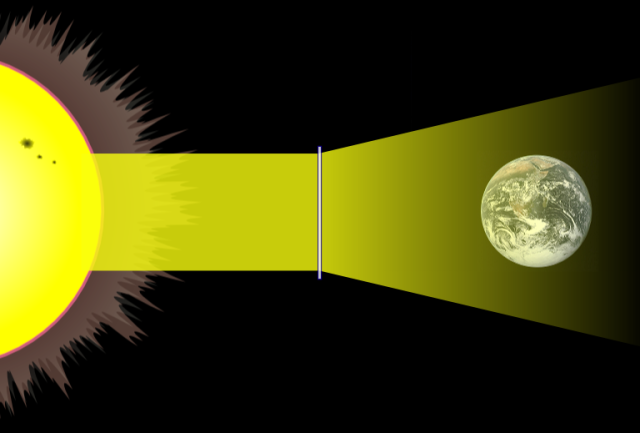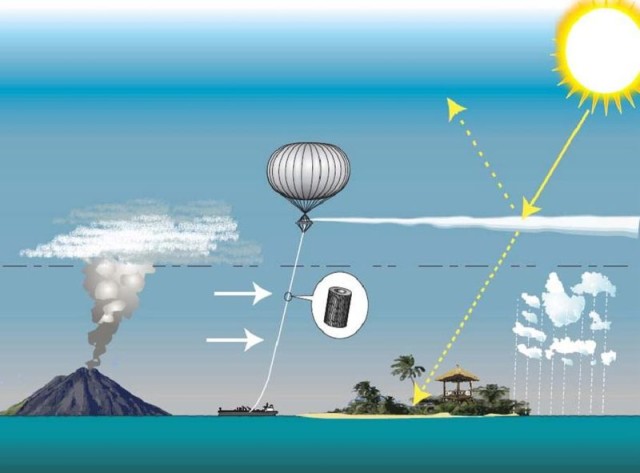-
Engineering the Climate—or Deploying Disaster? Applying Just War Theory to Geoengineering

As the national security ramifications of climate change grow more pronounced, climate manipulation technologies, known as geoengineering, will become more attractive as a method of staving off climate-related security emergencies. However, geoengineering technologies could disrupt the global ecological status quo, and could pose a potentially coercive (and very serious) threat to peace. Is it possible to obtain the potential benefits of these game-changing technologies, while avoiding spurring violence and conflict? In a recent article in Strategic Studies Quarterly, we argue that just war theory—which defines the concepts of “right” and “wrong” in warfare—could provide ethical standards for security decision-makers as they consider whether or how geoengineering should be used to address the climate challenge.
Geoengineering in the Global Commons
Geoengineering technologies fall into two distinct types, carbon dioxide removal and solar radiation management. Carbon dioxide removal includes any method of removing CO2 or other heat-trapping gases from the ambient air with the intention of reducing the greenhouse effect and allowing more heat to escape the atmosphere. Solar radiation management seeks to bounce sunlight away from the earth before it has the chance to be absorbed and re-radiated from the surface as infrared heat, becoming trapped in the atmosphere and contributing to the greenhouse effect.
Most methods can be deployed from land, and so would be subject to the national laws and norms of governance in the country where they are deployed. However, three current methods—ocean iron fertilization, sulfur aerosol dispersal, and marine-based cloud brightening—can be deployed from the high seas or the atmosphere, which are a part of the shared global commons, not national territory. Because the environmental cause and effect are separated in space and time, a sovereign state acting in these arenas could unilaterally affect the entire planet’s ecology.
Collateral damage to the environment during combat is one of the most significant costs of war. UN Environment’s post-conflict environmental assessments in Afghanistan, Iraq, Gaza, and Sudan show that destruction of the environment or disruption of ecosystem services hinders the recovery of the civilian population. Any geoengineering technology on a scale large enough to shift the global climate has the potential to inflict damage of the same magnitude.
Depending upon the type of technology used, geoengineering could incur the same level of cross-border environmental destruction and loss of functional sovereignty as a war. But war is waged with intent to harm; and geoengineering might be deployed without that intent. However, that is a distinction without a difference, if it causes involuntary environmental change that affects the security and material well-being of states, just like the use of violent force.

Towards a “Just Geoengineering” Theory
The centuries-long intellectual and legal history of just war theory provides ethical guidance for decision-making about the destructive forces of war. Three of its principles apply to geoengineering: competent authority, proportionality, and discrimination.
- Competent authority: Only the legitimate government of a sovereign state—in conjunction with scientists, inter-governmental organizations, and other stakeholders—can justly decide to use geoengineering. Any rogue actors are not legitimate.
- Proportionality: Any hoped-for ecological and economic benefits gained by deployment of geoengineering must outweigh the ecological and economic risks. In other words, geoengineering must make the problem better, not worse.
- Discrimination: The government cannot benefit its own people at the environmental expense of others, and collateral damage must be minimized.
Drawing on these three principles, we can formulate a Just Geoengineering Theory with two sets of guidelines: (1) on the decision to deploy—“jus ad climate”—following the model of jus ad bellum, law governing the decision to resort to force; and (2) on how the method should be deployed–“jus in climate”—following the model of jus in bello, law governing the conduct of war.
Jus ad climate:
- The state must be facing a major climate change-related security emergency in order to justify deploying geoengineering technologies from the global commons. The competent authority must determine a threshold—such as lost lives or economic productivity—that determines whether the emergency is “major” enough to justify the use of geoengineering.
- The decision must be made first at the national level, and then subject to international consent. States do not normally submit their national security decisions to the approval of other states, but geoengineering technologies are not like other weapons due to their unique combination of global reach, potential for nonlinear effect, and implications for the fundamental livability of our planet.
- The selected technology should have a reasonable chance of success, according to the best available scientific expertise. If this cannot be determined, then its use is not just, and the precautionary principle—avoid harm to environment or human health—must be applied.
- Any geoengineering attempt must meet the double-effect criteria: only the good result is intended; the bad is not a means to the good, and the deploying state is not engaging in harm for harm’s sake.
Jus in climate:
- The chosen method must be designed to inflict only the minimum ecological disruption necessary to offset the climate emergency. According to the just war principle of proportionality, states may use only the amount of force necessary to achieve their goal. When applied to geoengineering, determining this minimum requires input from scientists and stakeholders.
- The geoengineering method must yield greater good than harm globally (not just to the country deploying it); and do so starting with the first year of deployment. If not, it must be discontinued as ineffective or unjust. A short time threshold to prove the technology is critical, because unjust or unworkable strategies can cause significant environmental and economic damage, on top of the climate change effects they are trying to mitigate.
There’s No Planet B
Right now, climate change-related security threats are increasing, while mitigation and adaptation efforts are not keeping pace. Eventually, geoengineering will start to look like viable climate manipulation measures, cloaked in national security; already the U.S. Congress is considering expanding such research in the name of national security. However, law and custom require states to keep environmental harm from negatively affecting other states, and geoengineering deployed from the global commons offers no possibility of limiting the effects to one country or region.
So why don’t the countries of the world negotiate a new geoengineering regime? Ultimately, we must do just that, but the growing strain of nationalism in the world is pointing toward fewer treaties and less cooperation on global issues, and signals a retreat from the liberal international order needed to develop and implement a geoengineering convention. In the absence of explicit international law, just geoengineering theory can help to create a set of norms and customs to guide decision-making by states and the international community.
Elizabeth L. Chalecki is an Assistant Professor of International Relations at the University of Nebraska–Omaha and a Non-Resident Research Fellow in Environmental Security at the Stimson Center. Her expertise lies in the areas of climate change and security, global environmental politics, and the intersection of science & technology and international relations.
Lisa Ferrari is Associate Professor of Politics and Government at the University of Puget Sound, where she teaches in the areas of international relations, international ethics, and U.S.-Canadian relations.
Sources: Forum for Climate Engineering Assessment, Internet Encyclopedia of Philosophy, Scientific American, Science & Environmental Health Network, SSRN, Strategic Studies Quarterly, The National Academies of Sciences Engineering Medicine, The Washington Post, UN Environment, and U.S. Congress
Photo Credits: Principle of a space lens, April 2008, courtesy of Mikael Häggström; The SPICE Project, September 2011, courtesy of user Hughhunt.
 A Publication of the Stimson Center.
A Publication of the Stimson Center.




